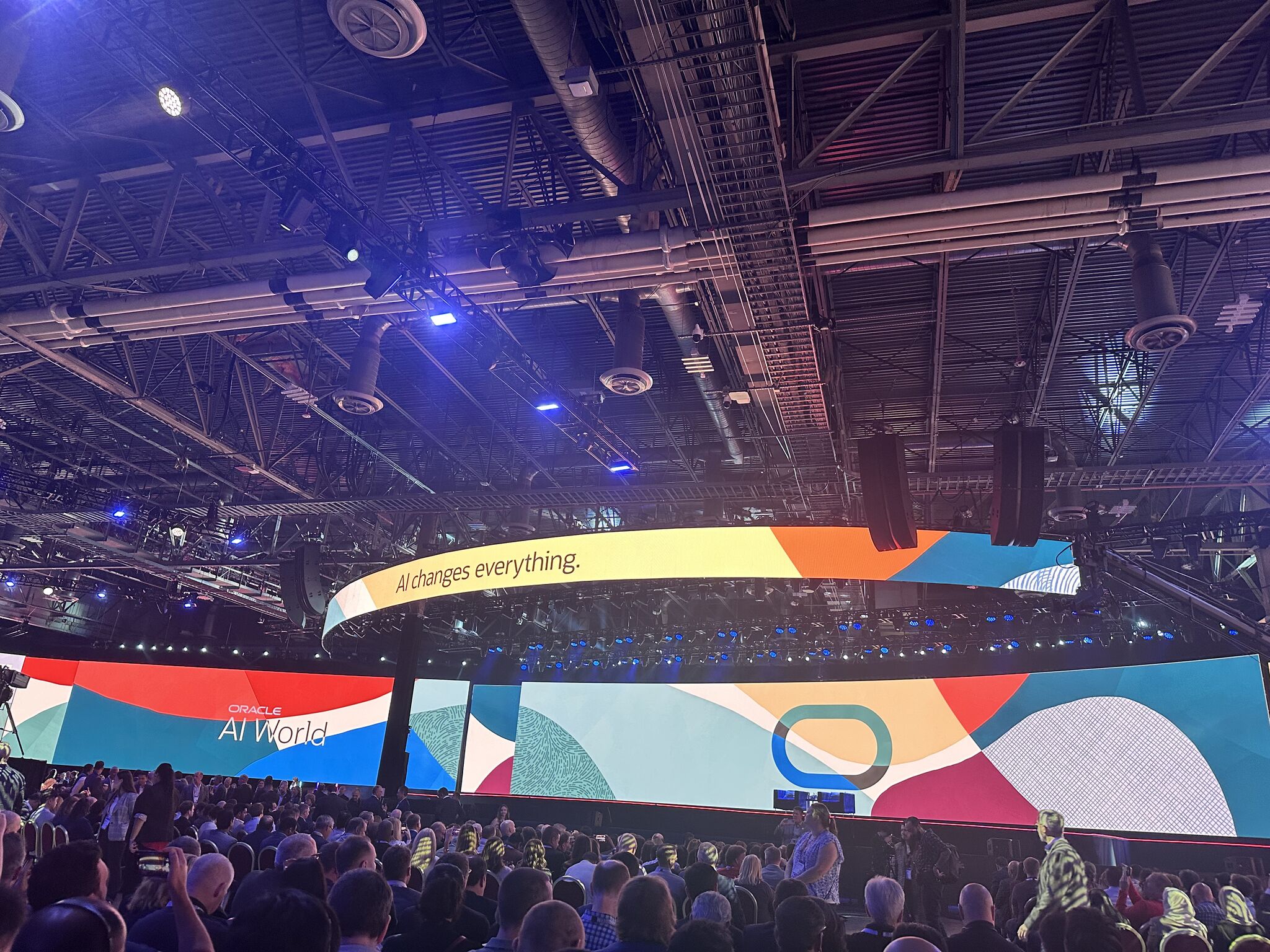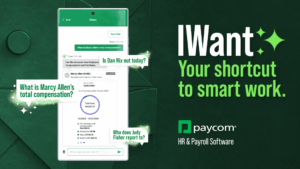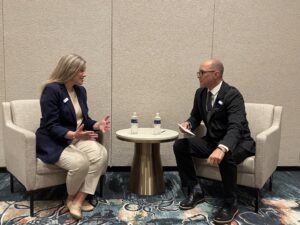Oracle AI World 2025 – It’s Time to Operationalize AI Systems
October 15, 2025
At Oracle AI World this week, Chris Leone – Oracle’s Executive Vice President of Applications Development, delivered one of the most comprehensive and confident presentations yet on how the company is infusing artificial intelligence throughout its enterprise Fusion Applications software portfolio.
His presentation on AI in Oracle Fusion Applications made one thing abundantly clear: Oracle believes 2026 will be the year organizations truly operationalize AI – representing the shift from targeted pilots and smaller experiments in 2025 to scaled, embedded, enterprise-wide automation.
And unlike many of its competitors, Oracle’s approach is more fundamental than most. Oracle is not talking about adding a new “Copilot” alongside of existing workflows and processes, or embedding a chatbot next to existing screens. It’s about rebuilding the fabric of enterprise systems themselves and how they automate, reason, and act in a way such that AI becomes an integral part of the way work actually gets done.
From Pilots to Enterprise AI
Chris, who has always been one of the industry’s most effective communicators, framed Oracle’s message around a simple but powerful concept: moving from AI pilots that stall to AI automation that scales. Over the last two years, more than 5,000 Oracle customers have deployed AI services and agents across their organizations. Yet, the company sees the next phase, more comprehensive and deep enterprise-grade automation as the true goal – as soon as 2026.
To support that transformation, Oracle has defined what it calls the Four Pillars of Enterprise AI:
- Connected Systems and Unified Data: Fusion Applications operate on a single, consistent data model spanning HR, finance, supply chain, and CX. This unified foundation enables AI to reason across the enterprise rather than within isolated silos.
- Enterprise-Grade Infrastructure: Built on Oracle Cloud Infrastructure (OCI), the system delivers the uptime, scalability, and performance that modern AI workloads demand. Pillars 1 and 2 combine to give Oracle a powerful advantage over many other “applications only” providers in the market.
- Transparency and Reliability: Tools to test, trace, and evaluate AI agents directly inside Fusion help ensure semantic accuracy and responsible results.
- Protection and Governance: Security and auditability are embedded at every level, with role-based access, data protection, content moderation, and “jailbreak” prevention baked in, not bolted on.
These pillars define what Oracle means by “Enterprise AI” where your systems can automate complex workflows, across the enterprise, using the latest in infrastructure and LLMs, while maintaining the guardrails and trust required for real-world business processes. This approach leverages the key strengths of Oracle, and its differentiators from its competitors.
A Platform Built for Scale: Fusion + OCI
Where Oracle stands out is in the tight integration between its Fusion Applications and its OCI cloud infrastructure. The company is both an applications provider and a technology platform, which provides it with a unique ability to control the full AI stack.
At the center of this is AI Agent Studio. Released in March of this year, this is Oracle’s low-code/no-code development environment that allows customers, partners, and Oracle Product Development to build, test, and deploy AI agents for customers at scale. These agents are built on a unified data layer and can leverage any of the leading large language models, e.g., OpenAI, Anthropic, Cohere ,Google’s Gemini. Many of these can now run natively within OCI for customers who require data residency and privacy assurances. This allows a customer to keep their data and their AI deployments completely within the Oracle Cloud.
Another key differentiator is flexibility and openness; Oracle’s own product teams use the same Agent Studio tools that customers and partners use, ensuring consistency and rapid innovation across the ecosystem.
AI in Action: Workflow Agents, Marketplace, and Observability
Chris shared that now Oracle Fusion Application’s AI capabilities now span a full spectrum of automation, from deterministic workflow logic to autonomous agent teams that collaborate toward a shared goal. He showcased three major areas of innovation driving that expansion.
- Workflow Agents: Automating Document-Driven Processes
These new agents simulate how a human would process a document step-by-step – reading, understanding, validating, and taking action based on the assessment of the earlier steps.
For example, the Agent can extract and verify data from supplier quotes, invoices, or court orders for things like payroll garnishments, check for accuracy (currency, units of measure, payment terms), and then automatically create corresponding transactions inside Fusion Applications. Chris live-demoed this in action showing how quickly and accurately a supplier quote can be transformed into a corresponding Purchase requisition.
This kind of semantic automation is powered by large language models that can interpret text, images, and tables far beyond traditional OCR capabilities, which has the potential to dramatically reduce the time and manual effort tied to document processing.
- The AI Agent Marketplace: Partner-Built Intelligence
Oracle is launching a new Agent Marketplace, allowing system integrators and ISV partners to create and distribute their own enterprise-grade agents directly inside Fusion Applications.
Each agent undergoes a 21-point inspection which is the same review Oracle applies to its own AI services, and covers safety, performance, accuracy, and token usage. Importantly, partner-built agents are supported by Oracle just like its native ones, a key distinction from competing ecosystems such as Salesforce AppExchange or SAP Store. There are also over 400 Oracle-built agents available in Fusion Apps, and hundreds more from partners in the Agent Studio. Plus, Chris shared that over 32,000 people have been trained and certified in the Agent Studio – making access to talent with the needed skills readily available in the Oracle ecosystem.
- Observability and Evaluation: Building Trust in AI
To deliver AI responsibly at enterprise scale, Oracle has embedded observability tools that allow organizations to test and score their agents on accuracy, latency, and semantic correctness. Using “LLM-as-a-Judge” techniques, customers can evaluate whether AI outputs are relevant and complete, not just factually right.
These evaluation and tracing capabilities that are built directly into AI Agent Studio make Oracle’s platform one of the few in the market where responsible AI governance is operationalized, not theoretical. There is another important point to make here as well. Operationalized, enterprise AI provides organizations with critical management, measurement, and governance capabilities that are simply not available when employees simply “bring their own AI” to work and use publicly available AI tools outside of the IT/CFO/CHRO auspices.
How Oracle Stacks Up Against Competitors
Oracle’s AI message inevitably invites comparison to the other big players in enterprise software, each of whom is racing to define its own AI story. Let’s take a quick look at how these latest Oracle AI announcements compare to what we are seeing in the wider market from a few selected companies.
Workday
Workday’s approach centers on embedding proprietary AI into workflows, primarily leveraging AWS infrastructure. While effective for specific HR use cases, it offers less flexibility for multi-model development or cross-application orchestration. Oracle differentiates by combining multi-model support, OCI-based data control, and an open developer studio.
SAP
SAP’s “Business AI” and Joule assistant focus on contextual recommendations and insights. Oracle’s Fusion AI, by contrast, goes broader by embedding agent-based automation throughout every module and enabling a thriving partner marketplace for industry-specific solutions.
Microsoft
Microsoft’s Copilot strategy is powerful in productivity and user experience, particularly within the Microsoft 365 ecosystem. Oracle’s vision, however, is more fundamental and wide-ranging and is aimed at automating end-to-end enterprise processes rather than just enhancing conversational interactions.
ServiceNow
ServiceNow is perhaps the closest in spirit to Oracle’s operational AI vision. Its Now Assist and Generative AI Controller delivers automation within ITSM, HR service delivery, and operations workflows which is similar to Oracle’s concept of embedded, domain-specific agents.
However, Oracle differentiates by spanning every business function (HR, finance, supply chain, CX) with a unified data model and a common AI framework. ServiceNow’s model remains more service-centric and focused on process automation and case management rather than transactional systems of record.
Where ServiceNow excels in workflow experience and ease of use, Oracle’s advantage lies in its integration depth and native connection to enterprise data through Fusion and OCI. The two approaches may ultimately converge, but Oracle’s broader scope positions it closer to becoming a full-stack AI platform for enterprise operations.
Oracle’s Edge
One of Oracle’s repeated messages at AI World is that AI needs to be “built-in, not bolted-on”. This hook line underscores its advantage over the competition. The integration of applications, infrastructure, and AI within one platform allows Oracle to iterate faster and deliver a more coherent enterprise experience than competitors that rely on external clouds, third-party tools, or who only possess limited enterprise process applications support.
Implications for HR and Enterprise Leaders
For HR technology professionals, Oracle’s Fusion HCM users will increasingly experience AI not as a separate tool but as an integral part of everyday work: agents that summarize resumes, guide compensation reviews, or flag data anomalies while maintaining strict security and compliance boundaries. As Oracle continues to deliver new Agents, and the Agent Builder usage becomes more widespread, HR teams using Oracle HCM will be empowered to leverage AI in all aspects of the function.
For CIOs and CHROs, the larger message is strategic. Oracle’s AI direction represents a re-architecture of enterprise systems and is more than just a new feature layer. These AI solutions and capabilities are about designing for automation, reasoning, and collaboration across the enterprise, taking us to a place where AI becomes a silent co-worker embedded in every process.
Across the industry, Oracle’s latest announcements reinforce the broader trend toward platform-level AI integration. The winners in this next phase of enterprise technology won’t be those who bolt AI on top of legacy systems, but those who bake it into the DNA of their applications and data platforms.
Our Take: Oracle’s Path Forward
At H3 HR Advisors, we’ve tracked the evolution of AI across HR and enterprise technology for the last several years, and we see Oracle’s approach standing out for a few key reasons:
- First, it blends trust with ambition by emphasizing security, governance, and observability alongside rapid innovation across the applications suite.
- Next, it positions AI as a capability, not a product. AI is something native to the platform, not an optional add-on that requires extra costs or investments, or heavy, complex adoption cycles.
- Finally, it’s clearly designed for scale and depth of capability. leveraging the combined strength of Fusion Applications, OCI, and a rapidly expanding ecosystem of trained developers and certified partners.
As we head into 2026 and what Chris Leone called “the year to operationalize AI”, Oracle’s strategy provides a glimpse of what enterprise AI maturity might really look like: automation that is trustworthy, transparent, and deeply embedded in the flow of work.
In our view, that’s the model all enterprise software providers and their customers will need to follow to realize the best outcomes and most impact from their AI initiatives.
At H3 HR Advisors, we’ll continue to analyze how the leading HR and enterprise technology providers are delivering their AI promises and what these advances mean for HR, IT, and business leaders navigating the next wave of transformation.
Look for more news and insights from Oracle AI World in an upcoming series of HR Happy Hour Media Network podcast episodes.
How we can help
Led by Trish Steed and Steve Boese, H3 HR Advisors harnesses over 40 years of experience to delivery HCM insights and guidance to global organizations.
H3 HR Advisory services
By leveraging technology, analytics, and our deep industry knowledge we can help you to reposition your workforce and ensure that you have the right people with the right capabilities in the right roles to positively impact the growth of your business.
HR Happy Hour Podcast Network
Created in 2009, The HR Happy Hour Show is hosted by Steve Boese and Trish Steed and is the longest continuously running internet radio show and podcast on Human Resources, HR Technology, Talent Practices, Workplace and Leadership topics.
H3 HR Speaking Services
We work closely with every client to customize your content - keynotes, webinars, research, infographics, and buyer’s guides - to inspire, educate and inform the audience enabling you to reset and realign your organization for a talent-led breakthrough.
Get in touch
Talk to us today and find out how we can help you and your organization leverage HCM technology to attract, onboard, retain and manage top talent.




